
A | B | C | D | E | F | G | H | CH | I | J | K | L | M | N | O | P | Q | R | S | T | U | V | W | X | Y | Z | 0 | 1 | 2 | 3 | 4 | 5 | 6 | 7 | 8 | 9
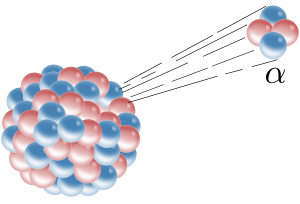
| Nuclear physics |
|---|
 |
Radioactive decay (also known as nuclear decay, radioactivity, radioactive disintegration, or nuclear disintegration) is the process by which an unstable atomic nucleus loses energy by radiation. A material containing unstable nuclei is considered radioactive. Three of the most common types of decay are alpha, beta, and gamma decay. The weak force is the mechanism that is responsible for beta decay, while the other two are governed by the electromagnetism and nuclear force.[1]
Radioactive decay is a stochastic (i.e., random) process at the level of single atoms. According to quantum theory, it is impossible to predict when a particular atom will decay, regardless of how long the atom has existed.[2][3][4] However, for a significant number of identical atoms, the overall decay rate can be expressed as a decay constant or as half-life. The half-lives of radioactive atoms have a huge range; from nearly instantaneous to far longer than the age of the universe.
The decaying nucleus is called the parent radionuclide (or parent radioisotope[note 1]), and the process produces at least one daughter nuclide. Except for gamma decay or internal conversion from a nuclear excited state, the decay is a nuclear transmutation resulting in a daughter containing a different number of protons or neutrons (or both). When the number of protons changes, an atom of a different chemical element is created.
There are 28 naturally occurring chemical elements on Earth that are radioactive, consisting of 34 radionuclides (six elements have two different radionuclides) that date before the time of formation of the Solar System. These 34 are known as primordial nuclides. Well-known examples are uranium and thorium, but also included are naturally occurring long-lived radioisotopes, such as potassium-40.
History of discovery
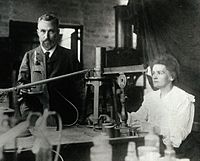
Radioactivity was discovered in 1896 by scientists Henri Becquerel and Marie Skłodowska-Curie, while working with phosphorescent materials.[5][6][7][8][9] These materials glow in the dark after exposure to light, and Becquerel suspected that the glow produced in cathode ray tubes by X-rays might be associated with phosphorescence. He wrapped a photographic plate in black paper and placed various phosphorescent salts on it. All results were negative until he used uranium salts. The uranium salts caused a blackening of the plate in spite of the plate being wrapped in black paper. These radiations were given the name "Becquerel Rays".
It soon became clear that the blackening of the plate had nothing to do with phosphorescence, as the blackening was also produced by non-phosphorescent salts of uranium and by metallic uranium. It became clear from these experiments that there was a form of invisible radiation that could pass through paper and was causing the plate to react as if exposed to light.
At first, it seemed as though the new radiation was similar to the then recently discovered X-rays. Further research by Becquerel, Ernest Rutherford, Paul Villard, Pierre Curie, Marie Curie, and others showed that this form of radioactivity was significantly more complicated. Rutherford was the first to realize that all such elements decay in accordance with the same mathematical exponential formula. Rutherford and his student Frederick Soddy were the first to realize that many decay processes resulted in the transmutation of one element to another. Subsequently, the radioactive displacement law of Fajans and Soddy was formulated to describe the products of alpha and beta decay.[10][11]
The early researchers also discovered that many other chemical elements, besides uranium, have radioactive isotopes. A systematic search for the total radioactivity in uranium ores also guided Pierre and Marie Curie to isolate two new elements: polonium and radium. Except for the radioactivity of radium, the chemical similarity of radium to barium made these two elements difficult to distinguish.
Marie and Pierre Curie's study of radioactivity is an important factor in science and medicine. After their research on Becquerel's rays led them to the discovery of both radium and polonium, they coined the term "radioactivity"[12] to define the emission of ionizing radiation by some heavy elements.[13] (Later the term was generalized to all elements.) Their research on the penetrating rays in uranium and the discovery of radium launched an era of using radium for the treatment of cancer. Their exploration of radium could be seen as the first peaceful use of nuclear energy and the start of modern nuclear medicine.[12]
Early health dangers

The dangers of ionizing radiation due to radioactivity and X-rays were not immediately recognized.
X-rays
The discovery of X‑rays by Wilhelm Röntgen in 1895 led to widespread experimentation by scientists, physicians, and inventors. Many people began recounting stories of burns, hair loss and worse in technical journals as early as 1896. In February of that year, Professor Daniel and Dr. Dudley of Vanderbilt University performed an experiment involving X-raying Dudley's head that resulted in his hair loss. A report by Dr. H.D. Hawks, of his suffering severe hand and chest burns in an X-ray demonstration, was the first of many other reports in Electrical Review.[14]
Other experimenters, including Elihu Thomson and Nikola Tesla, also reported burns. Thomson deliberately exposed a finger to an X-ray tube over a period of time and suffered pain, swelling, and blistering.[15] Other effects, including ultraviolet rays and ozone, were sometimes blamed for the damage,[16] and many physicians still claimed that there were no effects from X-ray exposure at all.[15]
Despite this, there were some early systematic hazard investigations, and as early as 1902 William Herbert Rollins wrote almost despairingly that his warnings about the dangers involved in the careless use of X-rays were not being heeded, either by industry or by his colleagues. By this time, Rollins had proved that X-rays could kill experimental animals, could cause a pregnant guinea pig to abort, and that they could kill a foetus. He also stressed that "animals vary in susceptibility to the external action of X-light" and warned that these differences be considered when patients were treated by means of X-rays.[citation needed]
Radioactive substances

However, the biological effects of radiation due to radioactive substances were less easy to gauge. This gave the opportunity for many physicians and corporations to market radioactive substances as patent medicines. Examples were radium enema treatments, and radium-containing waters to be drunk as tonics. Marie Curie protested against this sort of treatment, warning that "radium is dangerous in untrained hands".[17] Curie later died from aplastic anaemia, likely caused by exposure to ionizing radiation. By the 1930s, after a number of cases of bone necrosis and death of radium treatment enthusiasts, radium-containing medicinal products had been largely removed from the market (radioactive quackery).
Radiation protection
Only a year after Röntgen's discovery of X rays, the American engineer Wolfram Fuchs (1896) gave what is probably the first protection advice, but it was not until 1925 that the first International Congress of Radiology (ICR) was held and considered establishing international protection standards. The effects of radiation on genes, including the effect of cancer risk, were recognized much later. In 1927, Hermann Joseph Muller published research showing genetic effects and, in 1946, was awarded the Nobel Prize in Physiology or Medicine for his findings.
The second ICR was held in Stockholm in 1928 and proposed the adoption of the röntgen unit, and the International X-ray and Radium Protection Committee (IXRPC) was formed. Rolf Sievert was named chairman, but a driving force was George Kaye of the British National Physical Laboratory. The committee met in 1931, 1934, and 1937.
After World War II, the increased range and quantity of radioactive substances being handled as a result of military and civil nuclear programs led to large groups of occupational workers and the public being potentially exposed to harmful levels of ionising radiation. This was considered at the first post-war ICR convened in London in 1950, when the present International Commission on Radiological Protection (ICRP) was born.[18] Since then the ICRP has developed the present international system of radiation protection, covering all aspects of radiation hazards.
In 2020, Hauptmann and other 15 international researchers of eight nations, among which: Institutes of Biostatistics, Registry Research, Centers of Cancer Epidemiology, Radiation Epidemiology, and then also U.S. National Cancer Institute (NCI), International Agency for Research on Cancer (IARC) and Radiation Effects Research Foundation of Hiroshima studied definitively through meta-analysis the damage resulting from the "low doses" that have afflicted the populations of survivors of the atomic bombings of Hiroshima and Nagasaki and also in numerous accidents of nuclear plants that have occurred in the world. These scientists reported, in JNCI Monographs: Epidemiological Studies of Low Dose Ionizing Radiation and Cancer Risk, that the new epidemiological studies directly support excess cancer risks from low-dose ionizing radiation.[19] In 2021, Italian researcher Venturi reported the first correlations between radio-caesium and pancreatic cancer with the role of caesium in biology and in pancreatitis and in diabetes of pancreatic origin.[20]
Units
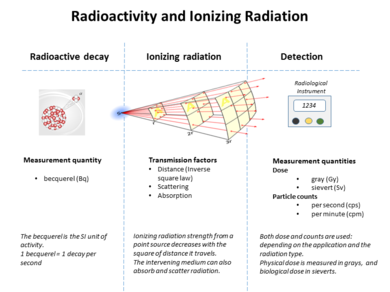
The International System of Units (SI) unit of radioactive activity is the becquerel (Bq), named in honor of the scientist Henri Becquerel. One Bq is defined as one transformation (or decay or disintegration) per second.
An older unit of radioactivity is the curie, Ci, which was originally defined as "the quantity or mass of radium emanation in equilibrium with one gram of radium (element)".[21] Today, the curie is defined as 3.7×1010 disintegrations per second, so that 1 curie (Ci) = 3.7×1010 Bq. For radiological protection purposes, although the United States Nuclear Regulatory Commission permits the use of the unit curie alongside SI units,[22] the European Union European units of measurement directives required that its use for "public health ... purposes" be phased out by 31 December 1985.[23]
The effects of ionizing radiation are often measured in units of gray for mechanical or sievert for damage to tissue.
Types
This section needs additional citations for verification. (May 2023) |
Radioactive decay results in a reduction of summed rest mass, once the released energy (the disintegration energy) has escaped in some way. Although decay energy is sometimes defined as associated with the difference between the mass of the parent nuclide products and the mass of the decay products, this is true only of rest mass measurements, where some energy has been removed from the product system. This is true because the decay energy must always carry mass with it, wherever it appears (see mass in special relativity) according to the formula E = mc2. The decay energy is initially released as the energy of emitted photons plus the kinetic energy of massive emitted particles (that is, particles that have rest mass). If these particles come to thermal equilibrium with their surroundings and photons are absorbed, then the decay energy is transformed to thermal energy, which retains its mass.
Decay energy, therefore, remains associated with a certain measure of the mass of the decay system, called invariant mass, which does not change during the decay, even though the energy of decay is distributed among decay particles. The energy of photons, the kinetic energy of emitted particles, and, later, the thermal energy of the surrounding matter, all contribute to the invariant mass of the system. Thus, while the sum of the rest masses of the particles is not conserved in radioactive decay, the system mass and system invariant mass (and also the system total energy) is conserved throughout any decay process. This is a restatement of the equivalent laws of conservation of energy and conservation of mass.
Alpha, beta and gamma decay
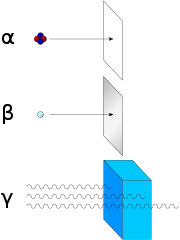
Early researchers found that an electric or magnetic field could split radioactive emissions into three types of beams. The rays were given the names alpha, beta, and gamma, in increasing order of their ability to penetrate matter. Alpha decay is observed only in heavier elements of atomic number 52 (tellurium) and greater, with the exception of beryllium-8 (which decays to two alpha particles). The other two types of decay are observed in all the elements. Lead, atomic number 82, is the heaviest element to have any isotopes stable (to the limit of measurement) to radioactive decay. Radioactive decay is seen in all isotopes of all elements of atomic number 83 (bismuth) or greater. Bismuth-209, however, is only very slightly radioactive, with a half-life greater than the age of the universe; radioisotopes with extremely long half-lives are considered effectively stable for practical purposes.
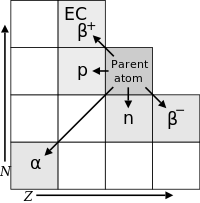
In analyzing the nature of the decay products, it was obvious from the direction of the electromagnetic forces applied to the radiations by external magnetic and electric fields that alpha particles carried a positive charge, beta particles carried a negative charge, and gamma rays were neutral. From the magnitude of deflection, it was clear that alpha particles were much more massive than beta particles. Passing alpha particles through a very thin glass window and trapping them in a discharge tube allowed researchers to study the emission spectrum of the captured particles, and ultimately proved that alpha particles are helium nuclei. Other experiments showed beta radiation, resulting from decay and cathode rays, were high-speed electrons. Likewise, gamma radiation and X-rays were found to be high-energy electromagnetic radiation.
The relationship between the types of decays also began to be examined: For example, gamma decay was almost always found to be associated with other types of decay, and occurred at about the same time, or afterwards. Gamma decay as a separate phenomenon, with its own half-life (now termed isomeric transition), was found in natural radioactivity to be a result of the gamma decay of excited metastable nuclear isomers, which were in turn created from other types of decay. Although alpha, beta, and gamma radiations were most commonly found, other types of emission were eventually discovered. Shortly after the discovery of the positron in cosmic ray products, it was realized that the same process that operates in classical beta decay can also produce positrons (positron emission), along with neutrinos (classical beta decay produces antineutrinos).
Electron capture
In electron capture, some proton-rich nuclides were found to capture their own atomic electrons instead of emitting positrons, and subsequently, these nuclides emit only a neutrino and a gamma ray from the excited nucleus (and often also Auger electrons and characteristic X-rays, as a result of the re-ordering of electrons to fill the place of the missing captured electron). These types of decay involve the nuclear capture of electrons or emission of electrons or positrons, and thus acts to move a nucleus toward the ratio of neutrons to protons that has the least energy for a given total number of nucleons. This consequently produces a more stable (lower energy) nucleus.
A hypothetical process of positron capture, analogous to electron capture, is theoretically possible in antimatter atoms, but has not been observed, as complex antimatter atoms beyond antihelium are not experimentally available.[24] Such a decay would require antimatter atoms at least as complex as beryllium-7, which is the lightest known isotope of normal matter to undergo decay by electron capture.[25]
Nucleon emission
Shortly after the discovery of the neutron in 1932, Enrico Fermi realized that certain rare beta-decay reactions immediately yield neutrons as an additional decay particle, so called beta-delayed neutron emission. Neutron emission usually happens from nuclei that are in an excited state, such as the excited 17O* produced from the beta decay of 17N. The neutron emission process itself is controlled by the nuclear force and therefore is extremely fast, sometimes referred to as "nearly instantaneous". Isolated proton emission was eventually observed in some elements. It was also found that some heavy elements may undergo spontaneous fission into products that vary in composition. In a phenomenon called cluster decay, specific combinations of neutrons and protons other than alpha particles (helium nuclei) were found to be spontaneously emitted from atoms.
More exotic types of decay
Other types of radioactive decay were found to emit previously seen particles but via different mechanisms. An example is internal conversion, which results in an initial electron emission, and then often further characteristic X-rays and Auger electrons emissions, although the internal conversion process involves neither beta nor gamma decay. A neutrino is not emitted, and none of the electron(s) and photon(s) emitted originate in the nucleus, even though the energy to emit all of them does originate there. Internal conversion decay, like isomeric transition gamma decay and neutron emission, involves the release of energy by an excited nuclide, without the transmutation of one element into another.
Rare events that involve a combination of two beta-decay-type events happening simultaneously are known (see below). Any decay process that does not violate the conservation of energy or momentum laws (and perhaps other particle conservation laws) is permitted to happen, although not all have been detected. An interesting example discussed in a final section, is bound state beta decay of rhenium-187. In this process, the beta electron-decay of the parent nuclide is not accompanied by beta electron emission, because the beta particle has been captured into the K-shell of the emitting atom. An antineutrino is emitted, as in all negative beta decays.
If energy circumstances are favorable, a given radionuclide may undergo many competing types of decay, with some atoms decaying by one route, and others decaying by another. An example is copper-64, which has 29 protons, and 35 neutrons, which decays with a half-life of 12.7004(13) hours.[26] This isotope has one unpaired proton and one unpaired neutron, so either the proton or the neutron can decay to the other particle, which has opposite isospin. This particular nuclide (though not all nuclides in this situation) is more likely to decay through beta plus decay (61.52(26)%[26]) than through electron capture (38.48(26)%[26]). The excited energy states resulting from these decays which fail to end in a ground energy state, also produce later internal conversion and gamma decay in almost 0.5% of the time.
List of decay modes
| Mode | Name | Action | Nucleus changes |
|---|---|---|---|
|
alpha emission | An alpha particle (A = 4, Z = 2) emitted from nucleus | (A − 4, Z − 2) |
|
proton emission | A proton ejected from nucleus | (A − 1, Z − 1) |
|
2-proton emission | Two protons ejected from nucleus simultaneously | (A − 2, Z − 2) |
|
neutron emission | A neutron ejected from nucleus | (A − 1, Z) |
|
2-neutron emission | Two neutrons ejected from nucleus simultaneously | (A − 2, Z) |
|
electron capture | A nucleus captures an orbiting electron and emits a neutrino; the daughter nucleus is left in an excited unstable state | (A, Z − 1) |
|
positron emission | A nuclear proton converts to a neutron by emitting a positron and an electron neutrino | (A, Z − 1) |
|
positron emission | In NUBASE2020, ß+ refers to the combined rate of electron capture (ε) and positron emission (e+): ß+ = ε + e+ | (A, Z − 1) |
|
β− decay | A nucleus emits an electron and an electron antineutrino | (A, Z + 1) |
|
double β− decay | A nucleus emits two electrons and two antineutrinos | (A, Z + 2) |
|
double β+ decay | A nucleus emits two positrons and two neutrinos | (A, Z − 2) |
|
β−-delayed neutron emission | A nucleus decays by β− emission to an excited state, which then emits a neutron | (A − 1, Z + 1) |
|
β−-delayed 2-neutron emission | A nucleus decays by β− emission to an excited state, which then emits two neutrons | (A − 2, Z + 1) |
|
β−-delayed 3-neutron emission | A nucleus decays by β− emission to an excited state, which then emits three neutrons | (A − 3, Z + 1) |
|
β+-delayed proton emission | A nucleus decays by β+ emission to an excited state, which then emits a proton | (A − 1, Z − 2) |
|
β+-delayed 2-proton emission | A nucleus decays by β+ emission to an excited state, which then emits two protons | (A − 2, Z − 3) |
|
β+-delayed 3-proton emission | A nucleus decays by β+ emission to an excited state, which then emits three protons | (A − 3, Z − 4) |
|
β−-delayed alpha emission | A nucleus decays by β− emission to an excited state, which then emits an α particle | (A − 4, Z − 1) |
|
β+-delayed alpha emission | A nucleus decays by β+ emission to an excited state, which then emits an a particle | (A − 4, Z − 3) |
|
β−-delayed deuteron emission | A nucleus decays by β− emission to an excited state, which then emits a deuteron | (A − 2, Z) |
|
β−-delayed triton emission | A nucleus decays by β− emission to an excited state, which then emits a triton | (A − 3, Z) |
|
cluster decay | A nucleus emits a specific type of smaller nucleus (A1, Z1) which is larger than an alpha particle (e.g. 14C, 24Ne) | (A − A1, Z − Z1) & (A1, Z1) |
|
internal (isomeric) transition | A nucleus in a metastable state drops to a lower energy state by emitting a photon or ejecting an electron | (A, Z) |
|
spontaneous fission | A nucleus disintegrates into two or more smaller nuclei and other particles, all of which may vary with each decay | variable |
|
β+-delayed fission | A nucleus decays by β+ emission to an excited state, which then undergoes spontaneous fission
Zdroj:https://en.wikipedia.org?pojem=Radioactive_decay Text je dostupný za podmienok Creative Commons Attribution/Share-Alike License 3.0 Unported; prípadne za ďalších podmienok. Podrobnejšie informácie nájdete na stránke Podmienky použitia.
Analytika
Antropológia Aplikované vedy Bibliometria Dejiny vedy Encyklopédie Filozofia vedy Forenzné vedy Humanitné vedy Knižničná veda Kryogenika Kryptológia Kulturológia Literárna veda Medzidisciplinárne oblasti Metódy kvantitatívnej analýzy Metavedy Metodika Text je dostupný za podmienok Creative
Commons Attribution/Share-Alike License 3.0 Unported; prípadne za ďalších
podmienok. www.astronomia.sk | www.biologia.sk | www.botanika.sk | www.dejiny.sk | www.economy.sk | www.elektrotechnika.sk | www.estetika.sk | www.farmakologia.sk | www.filozofia.sk | Fyzika | www.futurologia.sk | www.genetika.sk | www.chemia.sk | www.lingvistika.sk | www.politologia.sk | www.psychologia.sk | www.sexuologia.sk | www.sociologia.sk | www.veda.sk I www.zoologia.sk |
